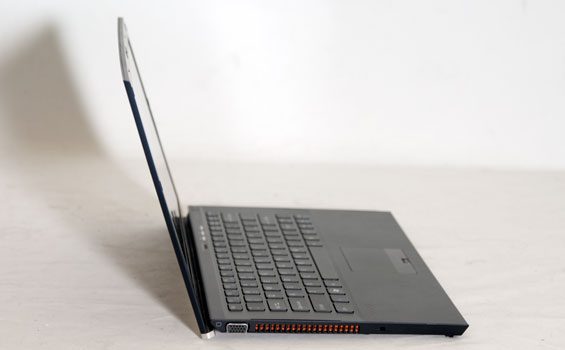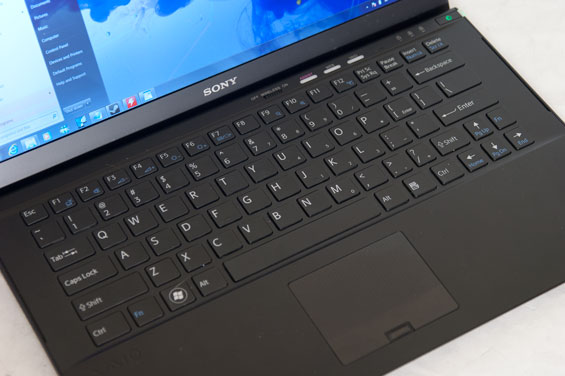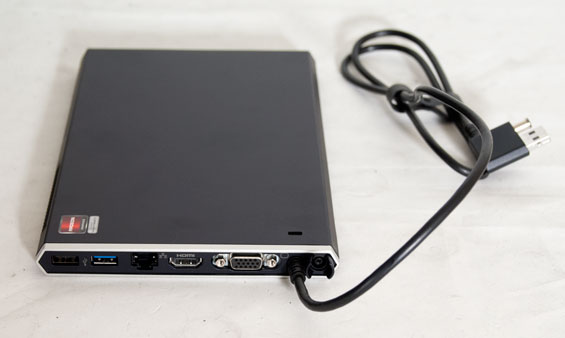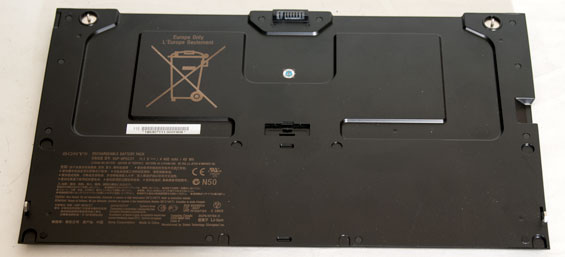Sony Vaio Z2: Everything is Peripheral
by Dustin Sklavos on February 13, 2012 12:55 AM ESTAccessories to a Crime
On paper, the Sony VAIO Z2 is an amazing ultraportable and promises just about everything a mobile professional could possibly want. It's less than three pounds, but get it hooked up to the wall with the docking station and suddenly it's a full featured notebook complete with DVD burner and dedicated graphics performance. Unfortunately, in many ways the Z2 fails to live up to its real potential.
The external design of the Z2 is attractive, as Sony employs a black carbon fiber shell over an aluminum frame for the notebook with glossy plastic used only for the VAIO logo on the lid. You can order it in gold or silver, but the matte black is beautiful enough on its own. There's also a silver accent along the hinge, and the inside and bottom of the notebook retain that sleek black carbon fiber design. This is a uniform, solid-looking notebook, and I have a hard time believing anyone will complain too much about it aesthetically.

So what's wrong with the shell design? It's utterly impractical. We'll start with the hinge, a design decision so atrocious I can't believe it actually made it to production. If you don't have the battery slice installed, the back of the hinge actually lifts the notebook off of whatever surface it's on, producing an incline for the keyboard. This is exactly the intended functionality, but the problem is that the only feet that provide any traction are the front two, causing the notebook to potentially slide during use. More than that, tilting the screen changes the entire incline of the notebook, making it that much harder to find a sweet spot for both typing and visual comfort. Using the battery slice alleviates this problem, but it's insane that you'd have to buy a $150 accessory just to improve ergonomics that should've been correct from the get go.

The Z2's problems don't really stop there, either. While keyboards are often a matter of some contention amongst you, the readership, the Z2's keyboard is a poster child for why so many people revile chiclet-style keyboards. Many of you don't have problems adjusting to notebook keyboards since there's so much variation between vendors, but this keyboard may very well put some of you over the edge. I have tiny, spidery fingers, and I couldn't keep from fat-fingering the keyboard. Depth and travel for the keyboard is horrendous, and key action is incredibly mushy.
The touchpad should fare better: it's dedicated as opposed to being a part of the rest of the shell, and has a fingerprint reader tucked away at the bottom. Unfortunately it's also smaller than you might like, and the touchpad and buttons are one piece of plastic instead of having a pair of dedicated mouse buttons. There isn't even a rocker switch, it's all just one piece. Once again, style over practicality.

Where the Z2 should redeem itself is the dock. While connectivity of the notebook on its own is quite good, the dock is undoubtedly where the action is. For what it's worth, Sony's Power Media Dock is a fantastic idea: it plugs into the AC adapter port and USB 3.0/dock port (it's not strictly USB 3.0, so don't try to use it with another notebook—it actually uses Intel's Light Peak technology for connectivity), and there's a pass-through for plugging in the AC adapter. Once it's hooked up, the Z2 detects it and asks you if you want the Radeon to power the interior screen or external monitors. This should be the feature that makes the Z2 alongside the stunning 1080p screen. Except there are major drawbacks.
The AMD Radeon HD 6650M inside the dock is limited to a PCI Express 2.1 x4 link instead of x8 or x16, and the performance hit is a noticeable one. Worse still, the only drivers you're going to find for the Radeon are on Sony's site: they don't use the publicly available drivers on AMD's site. You could argue that there's some secret sauce going on here, but the VAIO is using AMD's XGP standard, and either way you have yet another front where the 6650M is being hamstrung. I had to reboot the Z2 the first time I plugged the dock in just to get it to properly accelerate the internal monitor, and after that I still ran into the occasional problem during game testing; DiRT 3, for example, would only run windowed, and would only run on the Intel IGP.
Is the dock still better than nothing at all? Abso-freakin'-lutely. The 6650M is still a major upgrade on the Sandy Bridge IGP, and the added functionality (including the slimline optical drive) is appreciated. Unfortunately you're at Sony's mercy for driver updates, and we all know how reliable notebook manufacturers are at keeping video drivers current. We could also say that as long as you're going external, something a bit more potent than the 6650M would have been welcome; a 6770M would have boosted the clocks another 20%, and making the dock slightly bulkier shouldn't be too much of a problem.

Finally, there's the battery slice. Unlike the slice included with the VAIO S series we reviewed recently, this one actually requires you to screw the battery in to the bottom of the notebook. You rotate the outside edges with your thumbs and tighten the hold at the top. This seems like a sound idea, except the slice doesn't actually feel any more secure than the old latch-style locking system did. It's just a bit of added hassle. Thankfully the slice improves the ergonomics of the Z2 substantially without adding too much to the weight; the Z2 was already under three pounds, and the slice puts it a touch under four. It's an acceptable compromise for what the slice brings to the table.
















88 Comments
View All Comments
JarredWalton - Monday, February 13, 2012 - link
Have you done anything that puts the CPU load at 100% for ten minutes? If so, then it appears we have a case of wildly varying laptop thermals. The fact is that Dustin hit nearly 90C on the CPU, which is either a poor design decision, a poor sample, or perhaps both.As for the keyboard and touchpad, I've played with the Z2 as well. If you think it's good, that's your right, but I'm with Dustin: this is not a good (or comfortable) keyboard. The one major area where this laptop is awesome is the display. Everything else is "good" at best (e.g. you might like the styling), okay in some cases (I could live with the touchpad if only to get the display), or outright bad in other areas (graphics drivers, thermals, flimsy feel of chassis, and in at least our unit the noise levels).
I dare say that anyone who bought one of these laptops for $2000 or so to come and call our independent review "unfair" would have to qualify as a biased opinion. Others certainly like the design as well, but I'd rather have NVIDIA Optimus for the switchable graphics, and I'd like build quality to at least feel like a MacBook Pro. This has neither of those, which is a pretty serious drawback in my book.
Sea Shadow - Monday, February 13, 2012 - link
First of I would like to say thank you for your answers to my previous questions.2nd full disclosure, I don't have a Sony Z, I have a Lenovo x220t and I am calling your review not unfair but poor. In my opinion it is below Anandtech standards.
90C is quite common among laptops packing that type of processor. It's common for most MacBook Pros to hit 90-100c while at high load. I have had friends complain of theirs pushing past 100C when they are running windows on them. If anything I would consider it high praise for the VAIO Z to have a cool chassis while running at full tilt considering many Mac users complain of burning hot chassis with their MacBook Pros
Not bad considering that a Sony Z is thinner than the thickest point of a MacBook Air
By way of mention the safe max operating temperature of a 2620M is listed as 100C.
I have used a Z and the keyboard seemed plenty rigid to me, but that is just a matter of preference. I will agree that the keys were horribly squishy but I'm biased as I have a thinkpad *klack klack klack*.
OCedHrt - Monday, June 25, 2012 - link
Japanese laptops have always been designed with this "flimsiness." Take a look at Panasonic's line of portable toughbooks or Toshiba's R series. They are all a bit flimsy and I have never heard of anyone's laptop breaking from standard handling. There's a difference between flimsiness and cheap. If anything, my laptop fell out of my car onto tarmac and survived with just a minor chip on the corner. A more solid laptop could shatter in that scenario - just as how phone battery covers pop off but the phone is undamaged yet an iPhone 4's glass will shatter.I don't have this generation of Z laptops, but I got the last one for $1100 so I didn't exactly invest in a lot of money to be sore that I got a crappy product.
Johnmcl7 - Monday, February 13, 2012 - link
and you don't just pay a premium for styling and name, you're paying for cutting edge technology that will take other companies years to catch up to. My current Vaio is the older Z5 which is a proper Z series (whereas I wouldn't say the new ones are) which has the fastest mobile Core 2 Duo processor, a beautiful 1600x900 screen, twin graphics cards (internal and discrete), dual 128GB SSDs in RAID 0 and a blu-ray writer wrapped up in a carbon fibre chassis which is smaller and lighter than any of its rivals all which were much lower spec. In fact even machines further up the range struggled to meet its specification. It's easily the best laptop I've had as it easily mixes portability and performance.My oldest Vaio is a TX which is an 11.1in ultralight that dates back long before the netbooks and I bought for much the same reasons as the Z series, it was technologically far more advanced than any of its rivals and even years after machines would struggle to match it. In the ultralight category most companies cut corners to get the size and weight down which usually meant no optical drive, a very small 3 or 4 cell battery and a cut down range of ports with dongles required to get normal ports. The TX however did not, it had an onboard optical drive, its standard battery was the same size as rival extended battery and its extended battery was a massive 13,000Mah battery, it had a range of standard ports onboard and despite all that it was still smaller and lighter than its rivals which was some engineering feat. It was also one of the first laptops (if not the first) to use LED backlighting, again years ahead of everyone else.
I didn't like the older Vaios at all when they were going through their Apple phase when Vaios were the laptops to have which meant Sony could churn out rubbish and people would pay lots of money for it. But once they got past that stage and had to compete for business, their machines were far better. People complain about Macbooks being called overpriced when Vaios are more expensive but I disagree with that, with the Macbooks you're generally getting yesterday's technology or worse whereas Sony are giving you the best there is and frequently a long way ahead of anyone else. I was amused when sites like this one and Ars Technica were defending the C2D in the 13in Macbook because it wouldn't be physically possible to fit the three chips in, at the same time Sony were not only doing that with their Z series but also packing in a more powerful processor with quad SSDs into a chassis smaller and lighter than the Macbook.
So that's why I buy Sony laptops as I get the best the market has to offer and usually in the most compact package. I prefer the lack of manufacturer software and easier maintenance on some of the Dell machines but the latter is a reasonable price to pay for the smaller size.
John
bernstein - Tuesday, February 14, 2012 - link
FYI : i am currently using a Radeon 6950 in an open ended pcie x4 slot in conjunction with a 35W i3-2100T and you know what? i get a 5-15% penalty in frame rate across games. compared to a full x16 pcie slot.so stop writing shit like :
"even at our lowest benchmark settings in Battlefield 3, the GPU seemed hamstrung by the PCIe x4 bandwidth afforded by the Power Media Dock."
it it JUST NOT POSSIBLE for a 6650M gpu to be bandwith limited in a pcie x4 link. unless it used the ram as gpu memory, but that would make ZERO sense.
FYI: there are reviews out there that specifically analyze this, just google them up...
JarredWalton - Tuesday, February 14, 2012 - link
Let me help you out: "The GPU seemed hamstrung by the PCIe x4 bandwidth afforded by the Power Media Dock."In other words, given the specs the HD 6650M in the dock appears to be underperforming. I've got another laptop with an HD 6630M integrated into the laptop. Let me just give you the numbers from the upcoming review compared the the results of a *faster* HD 6650M in this review:
Batman AC: 56 (17% faster)
BF3: 27.2 (45% faster)
Civ5: 30.3 (76% faster)
DiRT3: 48.8 (98% faster)
Portal2: 102.2 (36% faster)
Skyrim: 40 (7% slower - this is the only game where the Z2 came out on top)
TWS2: 50.2 (40% faster)
Average performance of HD 6630M vs. Z2's docked HD 6650M: the integrated HD 6630M is 44% faster.
These results are from the same tests Dustin is using. What's causing the drop in performance? The dock. Is it because of copying the frame buffer back to the main display? Perhaps, but nevertheless the result is that the HD 6650M in the dock is hamstrung by something. We aren't certain that it's the dock (it could be drivers, for instance), but it SEEMS to be the dock bandwidth.
Penti - Wednesday, February 15, 2012 - link
You shouldn't forget that copying over the frame buffer to the integrated graphics does use a lot of memory. It will be more of a hit then when outputing directly from the gpu. I can depend a lot on the software/drivers. It's not really too little bandwidth though. 10GB/s bi-directional should be fine even for higher end gpus basically.aferox - Tuesday, February 14, 2012 - link
I have a couple of older Z's - a Z11 and Z13. I too prefer the "all-in-one" design of those models, and I have found them to be amazing machines. After 2 years of constant use, my Z11 is still holding up quite well. It looks almost new. The 330M is a better graphics card than I expected. I can play Skyrim quite comfortably with medium to high settings. The laptop is powerful enough to reasonably run genetic statistics analyses. The physical switch for graphics has had no impact, since it functions intelligently and I haven't had to touch it in ages. The keyboard feels a bit soft and mushy to me, with little tactile feedback from the keys, but not problematic. People seem to have a huge variety in preferences regarding keyboards. I like reviews to have detailed descriptions (clicky, soft, shallow key travel, etc.) rather than "good" or "bad". Adding qualified subjective statements is okay, but not sufficient. This review worked fine that way for me. The screen is excellent.The Z2 is an interesting laptop. Unfortunately, it has moved away from some of the features which made the older Z11-Z13 line so attractive to me. I don't want to carry around an external dock. It adds weight, which is a prime factor for me, and it is, well, a clunky solution. More connections to make when I want it, and more real estate gobbled up. If a laptop + dock weighs as much as a larger all-in-one, then I see no advantage for me. I don't travel with part of my system. I certainly don't care about thickness (3/4", 1", who cares?), but weight and robustness are all important. I prefer the old-style hinge with the power connector on one end and the switch on the other. The new touchpad has a different design, and again I prefer the old one with dedicated mouse buttons.
Lack of long-term support from Sony is a very valid question. Still, I'm able to run everything on my old model after 2 years, and that isn't bad.
In the end, the Z2 hasn't seemed like a compelling step up, but rather a step backwards in some areas important to me. I actually looked around and purchased the Z13 rather than a new Z2 because of that. Too bad Anandtech wasn't able to get review units when the Z11 appeared, because it was honestly jaw-dropping 2 years ago. In some ways, I believe the field is still catching up.
apudapus - Tuesday, February 14, 2012 - link
I own both the Z2 and the Z1 and think the Z1 was a much better machine. With the Z1, it was great having everything all-in-one and being able to play Portal 2 and SC2 on battery power. You can't do this with the Z2 because the power dock requires wall-power. The power dock is inconvenient for me because I play video games at home and at my girlfriend's place and it's tedious to safely disconnect the power dock when I'm traveling between places (versus just closing the lid on the Z1 and forcing it to sleep).Nonetheless, the Z2 is a great machine. It is the best portable laptop for me: small, super lightweight, yet powerful to compile code and play some video games. The portability and immediate on-off make it great to bring to meetings. The high resolution screen is definitely the best and was the biggest deciding factor for me. I hate that you have to go to a heavy 15" laptop to get better than 1366x768 res. The Z2 isn't for everyone but definitely worth it if you're looking for small size, portability, power, and playing some light video games (it does NOT play BF3). I wish I had this thing in college. I'd be in debt for a while but I'd have the best machine to work with. Yes, the keyboard sucks. They need to bring back the keyboard from the Z1!
Options I chose:
Blu-ray drive - I watch movies often
1920x1080 screen - Things look small but there's a lot of information I need to look at when I'm working
TrackSmart - Wednesday, February 15, 2012 - link
Not to make you feel bad, but why did you 'upgrade' from the Z1 to the Z2?I can't imagine any usage scenario where the Z2 would offer considerably greater performance or functionality. The old model was almost as portable and included the dedicated GPU and optical drive in the chassis.